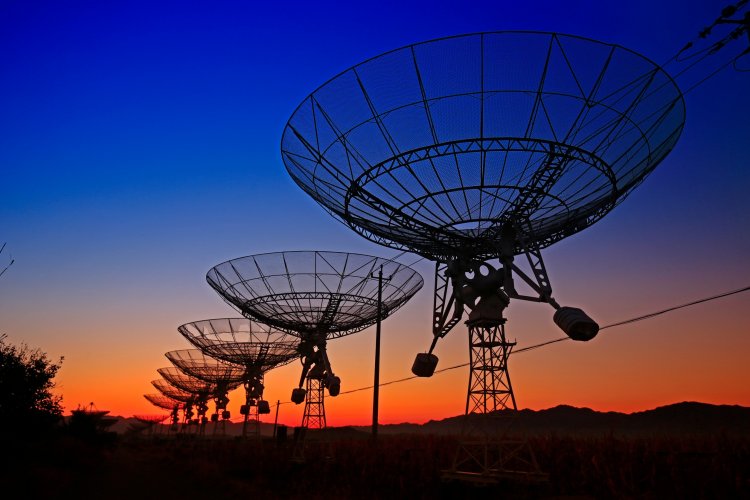It stopped being just a set of glasses in a casing a long time ago: To examine galaxies, stars and nebulae, telescopes are now sent into space and immersed deep underwater. Which technologies today help us see far away
Galileo was the first to aim a magnifying pipe at the sky to explore stars and other celestial bodies. In 1609, he created his first 3-power viewing scope and subsequently – a half-a-meter 8-power telescope. The very word telescope originates from the Ancient Greek tele – “far” and skopeo – “I see.”
The design of the early telescopes was quite simple. There were two lenses in the casing: a convex objective lens and an ocular – a concave lens. This design afforded a rather small field of vision and poor brightness. Scientists spent years perfecting telescopes. Johannes Kepler proposed a design with two converging lenses. Isaac Newton replaced the convex lens with a spherical mirror, creating a 40-power telescope. Laurent Cassegrain proposed a two-mirror design, with the parabolic first mirror and a convex hyperboloid as the second reflector. Nearly all designs had been developed by the end of the 17th century, and were just perfected later on.
Telescope today show all the ranges of the electromagnetic spectrum: there are optical telescopes, radio telescopes, X-ray and Gamma-ray telescopes. Neutrino detectors are called neutrino telescopes.
On the land
Now, a portable telescope would not help you to learn new things remote space bodies. Sky exploration equipment has turned into complete research stations long time ago.
One of the best modern telescopes is the twin device at W. M. Keck Observatory. The telescopes of the observatory were the largest in the world until the Gran Telescopio Canarias (GTC) was put into operation in 2007. W. M. Keck Observatory is two reflecting telescopes, with hexagonal mirrors, 10 meters in diameter, each consisting of 36 elements. The spectrometer of the observatory works in the near-infrared range; most exoplanets were discovered by that observatory. The adaptive optical system deals with distortions created by the atmosphere. The two telescopes are connected by an interferometer: the devices are about 85 meters apart, and their connection resulted in a resolution similar to that provided by telescope with a 85-m reflector.
New knowledge about the Universe can also be produced using promising optical research products: land-based telescopes with the main reflector over 20 m in diameter. Those are called extremely large telescopes; none has been built so far. There are designs for a 30-meter Telescope, the Large Magellan Telescope, and the Extremely Large Telescope. Scientists expect that the size of the mirrors that are going to be installed at the research stations, and the new generation of adaptive optic equipment will enhance image clearness and resolution beyond the level of the Hubble telescope.
Far away from cities, in locations with the lowest electromagnetic interference from radio, television and radars, giant dishes are being installed, with an antenna pointed at the sky. Radio telescopes receive and process radio waves and waves of other ranges of the electromagnetic spectrum from stars, planets, galaxies, and quasars.
The antennae are combined into a network. Their operation principle is similar to that of an optical telescope, except that they catch radio waves. The world’s largest radio telescope is in China: its surface area is equal to 30 football fields; its perimeter is 1.6 km. Its job, amongst other things, is to explore the radio emission stage of the Universe: there were no optical radiation before there were stars.
In the outer space
The Earth atmosphere impedes gamma radiation, X-ray and ultraviolet radiation from space objects. Telescopes are placed into orbit to explore remote space objects, free from atmospheric noise. The first orbital telescope was the Soviet satellite Kosmos 215, launched in 1968.
The Hubble Space Telescope is the most famous astronomical satellite. However, there are dozens of such devices revolving on the orbit, with various functions. Telescopes process information from all kinds of rays. Gamma rays are released by supernova neutron stars, pulsars and black holes. The Earth atmosphere absorbs them; therefore, such information can only be collected outside of it. Gamma rays are electromagnetic waves with an extremely short wave length: under 0.1 А.
From the orbit, X-ray telescopes register a flow of photons from clusters of galaxies and their nuclei, black holes, and supernova remains. X-ray telescopes have several methods of focusing rays. The more common type is Wolter telescopes, which are optical systems that only use grazing incidence mirrors. An X ray falls on such mirror at a very shallow angle to the reflecting surface; it is kind of sliding upon the surface. Normal mirrors and lenses cannot be used in X-ray telescopes since most of the radiation goes through the material or is absorbed by it.
Space telescopes also explore the Universe by registering and analyzing visible radiation (microwave, radio and infrared radiation). The future James Webb Space Telescope is going to focus on the infrared band. Its main mirror will be 6.5 m in diameter, which is 2.7 times greater than the mirror in the Hubble. Infrared radiation receivers allow it to register exoplanets with the temperatures similar to that of Earth.
Underwater
There is a telescope installed in March 2021 at the bottom of the lake Baikal, which is not helping explore the Universe. The neutrino telescope examines super-high energy neutrino flows from astrophysical sources.
Registering such neutrinos requires clear water in natural water bodies or purified water in artificial ones. Large amounts of water increase space in which a neutrino can move, and the purity prevents admixtures that can affect neutrino flight and registration.
Neutrinos are neutral particles that lack a charge, have a very low mass, and a speed close to light speed. Neutrinos have very weak interactions with the surrounding matter; scientists believe that neutrinos can fly from the depths of emerging or dying galaxies and reach Earth almost without changing, and may provide information on what was happening in the Universe millions of years ago and when.
Photo: lnpdm / ru.123rf.com
Sources: pacegid.com, new-science.ru, galspace.spb.ru






















